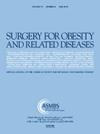减肥手术后他汀类药物的使用轨迹:匹配队列分析。
IF 3.5
3区 医学
Q1 SURGERY
引用次数: 0
摘要
背景:代谢和减肥手术(MBS)是肥胖症最持久的治疗方法,可减少他汀类药物的使用:我们比较了接受和未接受代谢与减肥手术的患者使用他汀类药物的轨迹:方法: 我们通过基于美国雇主的回顾性索赔数据库确定了体重指数≥ 35kg/m2 的成年人。患有 MBS 的患者与未患有 MBS 的患者进行 1:1 匹配。根据指数日期前一年他汀类药物的使用情况对他汀类药物的使用轨迹进行分层,并对指数日期后两年的他汀类药物使用情况进行检查:地点:大学医院:分析了 16,359 名患有 MBS 的成年人和 16,359 名未患有 MBS 的匹配成年人。两组中均有 19.4% 的人在指数日期前一年开过他汀类药物处方。在指数日期后的两年中,没有进行 MBS 的人群中使用他汀类药物的比例仍然相似,分别为 20%(第一年)和 19%(第二年),而在 MBS 群体中,使用他汀类药物的比例则分别降至 12.5%(第一年)和 9.3%(第二年)。在基线他汀类药物使用者中,35.4% 的非 MBS 和 60.4% 的 MBS 群体在指数日期后的 2 年内停止使用他汀类药物。在基线他汀类药物新使用者中,9.6%的非MBS队列在指数日期后2年内开始使用他汀类药物,而在MBS队列中,这一比例仅为2.6%:结论:他汀类药物基线使用者停用他汀类药物的情况非常明显,而他汀类药物基线使用者开始使用他汀类药物的情况则明显减少。这表明,MBS 既能治疗血脂异常,又能预防血脂异常。本文章由计算机程序翻译,如有差异,请以英文原文为准。
Statin use trajectories postbariatric surgery: a matched cohort analysis
Background
Metabolic and bariatric surgery (MBS) is the most durable treatment of obesity and can reduce statin use.
Objective
We compare statin use trajectories in patients with and without MBS.
Methods
Adults with a body mass index ≥ 35kg/m2 were identified using a U.S. employer-based retrospective claims database. Individuals who had MBS were matched 1:1 with those who did not. Trajectories of statin use were stratified by statin use in the year before the index date and examined in the 2 years after the index date.
Setting
University Hospital.
Results
Sixteen thousand three hundred fifty-nine adults who had MBS and 16,359 matched adults who did not were analyzed. In both groups, 19.4% filled a statin prescription in the year before the index date. In the 2 years after the index date, individuals using statins remained similar at 20% (year 1) and 19% (year 2) among those who didn’t have an MBS and decreased to 12.5% (year 1) and 9.3% (year 2) in the MBS cohort. Among baseline statin users, 35.4% of non-MBS and 60.4% of the MBS cohort stopped using statins within 2 years of the index date. Among statin naïve individuals at baseline, 9.6% of the non-MBS cohort started using statins within 2 years of the index date, compared to 2.6% of those who had MBS.
Conclusions
MBS results in a significant discontinuation of statins among baseline users, and significantly decreased the initiation of medications among individuals who were statin naive at baseline. This demonstrates that MBS is both a treatment and preventative measure for dyslipidemia.
求助全文
通过发布文献求助,成功后即可免费获取论文全文。
去求助
来源期刊
CiteScore
6.70
自引率
12.90%
发文量
570
审稿时长
56 days
期刊介绍:
Surgery for Obesity and Related Diseases (SOARD), The Official Journal of the American Society for Metabolic and Bariatric Surgery (ASMBS) and the Brazilian Society for Bariatric Surgery, is an international journal devoted to the publication of peer-reviewed manuscripts of the highest quality with objective data regarding techniques for the treatment of severe obesity. Articles document the effects of surgically induced weight loss on obesity physiological, psychiatric and social co-morbidities.

 求助内容:
求助内容: 应助结果提醒方式:
应助结果提醒方式:


